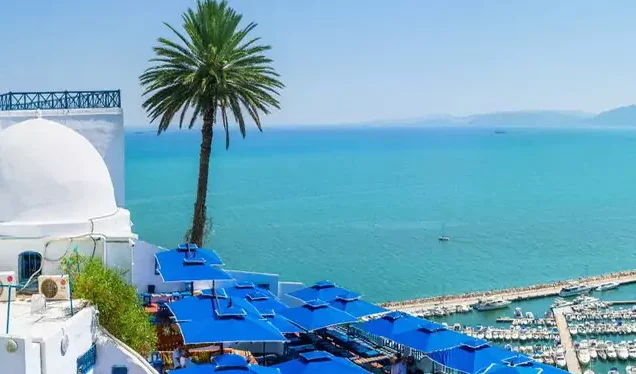

Introducing Tunisia
Tunisia, a land where history and natural beauty intertwine, invites you on a journey through time and culture. Nestled along the sparkling Mediterranean coast, this North African gem offers a captivating blend of ancient wonders, vibrant cities, and stunning landscapes. From the golden sands of the Sahara Desert to the azure waters of the Mediterranean, Tunisia is a destination that promises both adventure and relaxation.
Explore the ancient ruins of Carthage, where echoes of a powerful civilization still resonate, or wander through the labyrinthine alleys of Tunis’s medina, a UNESCO World Heritage site brimming with color and life. The Roman amphitheater of El Djem, one of the best-preserved in the world, stands as a testament to Tunisia’s rich historical tapestry.
Beyond its historical treasures, Tunisia is a land of contrasts. The coastal towns like Hammamet and Sousse are famous for their beautiful beaches and lively atmosphere, while the inland regions offer a serene escape into nature. The lush green mountains of the north, the salt flats of Chott El Jerid, and the vast expanse of the Sahara all showcase Tunisia’s diverse landscapes.
Whether you’re savoring the flavors of traditional Tunisian cuisine, relaxing in a luxurious seaside resort, or exploring the ancient Berber villages in the south, Tunisia offers a unique blend of experiences that will enchant and inspire you. Discover a country where every corner tells a story, and where the warmth of its people makes you feel right at home. Tunisia is not just a destination; it’s an experience waiting to be embraced.
- When is the Best Time to Visit Tunisia?
The best time to visit Tunisia largely depends on what you wish to experience during your trip, as the country offers a variety of climates and activities throughout the year.
Spring (March to May):
Spring is arguably the best time to visit Tunisia. The weather is mild, with temperatures ranging between 15°C and 25°C (59°F to 77°F). The landscapes are lush and green, especially in the north, and the cities and tourist spots are not too crowded. This season is perfect for exploring historical sites, such as the ancient city of Carthage or the medinas of Tunis and Sousse, and for enjoying outdoor activities like hiking in the Atlas Mountains.
Summer (June to August):
Summer in Tunisia can be quite hot, especially in the southern desert regions where temperatures can soar above 40°C (104°F). However, the coastal areas, such as Hammamet, Sousse, and Djerba, benefit from a Mediterranean climate with warm, sunny days and cooler nights. This is the peak tourist season, ideal for beach lovers who want to enjoy the sun, sea, and sand. Be prepared for bustling beach resorts and higher prices, especially in July and August.
Autumn (September to November):
Autumn is another excellent time to visit Tunisia. The intense summer heat begins to subside, and temperatures are pleasant, ranging from 20°C to 30°C (68°F to 86°F). The sea is still warm enough for swimming, and the crowds start to thin out, making it a good time to explore both coastal and inland regions. It’s also a great season for visiting the Sahara, with cooler temperatures making desert excursions more comfortable.
Winter (December to February):
Winter in Tunisia is generally mild, especially along the coast, with temperatures averaging between 10°C and 18°C (50°F to 64°F). While it’s not beach weather, winter is a fantastic time for cultural exploration, visiting archaeological sites, and enjoying the vibrant local life in cities like Tunis. The desert regions can get quite cold at night, but this is also the best time for experiencing the Sahara without the scorching heat. Winter is also less crowded, offering a more relaxed travel experience.
Ultimately, the best time to visit Tunisia depends on your preferences—whether you’re looking to bask in the sun, delve into history, or explore the desert, Tunisia offers something special year-round.
- Where Should you Go in Tunisia?
Tunisia is a land of diverse landscapes, rich history, and vibrant culture. Here are ten must-visit destinations to include in your itinerary:
- Tunis : The capital city, Tunis, is a fascinating blend of old and new. Explore the historic Medina, a UNESCO World Heritage site, where narrow streets are lined with markets, mosques, and palaces. Don’t miss the Bardo Museum, home to one of the world’s most important collections of Roman mosaics.
- Carthage: Just outside Tunis, the ancient city of Carthage is a treasure trove of archaeological wonders. Once a powerful Phoenician city, its ruins, including the Baths of Antoninus and the Punic Ports, offer a glimpse into its storied past.
- Sidi Bou Said: This picturesque village is perched on a hill overlooking the Mediterranean Sea. Known for its blue and white buildings, Sidi Bou Said is a haven for artists and offers stunning views, charming cafes, and a relaxed atmosphere.
- Dougga: Another UNESCO World Heritage site, Dougga is one of the best-preserved Roman cities in North Africa. Wander through the ruins of temples, baths, and a theater, set against a backdrop of rolling hills and olive groves.
- Sousse: Sousse is a coastal city known for its beautiful beaches and lively atmosphere. The Medina of Sousse, also a UNESCO World Heritage site, is a maze of narrow alleys, bustling markets, and historic architecture, including the Ribat and the Great Mosque.
- Hammamet: A popular resort town, Hammamet offers pristine beaches and a laid-back vibe. It’s the perfect place to relax by the sea, explore the old town, or enjoy the vibrant nightlife. The town is also known for its jasmine-scented streets and luxurious gardens.
- Djerba: The island of Djerba, located off the southern coast, is famed for its sandy beaches, whitewashed villages, and unique Berber culture. Visit the ancient El Ghriba Synagogue, the traditional pottery workshops in Guellala, and the bustling markets of Houmt Souk.
- Kairouan: As the fourth holiest city in Islam, Kairouan is steeped in religious significance and history. The Great Mosque of Kairouan is a masterpiece of Islamic architecture, and the city’s medina is a UNESCO World Heritage site full of spiritual and cultural heritage.
- Tozeur: Located at the edge of the Sahara, Tozeur is known for its expansive palm groves, traditional brick architecture, and the nearby Chott el Jerid, a vast salt lake. It’s also a gateway to desert adventures, including visits to the stunning mountain oasis of Chebika, Tamerza, and Mides.
- Matmata: Matmata is famous for its troglodyte homes—dwellings dug into the ground to provide natural insulation against the desert heat. This unique village gained international fame as a filming location for the original “Star Wars” movie, where it was depicted as Luke Skywalker’s home planet, Tatooine.
These destinations offer a perfect mix of Tunisia’s natural beauty, historical depth, and vibrant culture, providing a comprehensive experience of this North African gem.
- How Many Days Do You Need?
The ideal length of your stay in Tunisia largely depends on how much of the country you wish to explore and what experiences you want to prioritize. Here’s a general guide to help you plan:
Short Trip (3-5 Days):
- Focus Areas: Tunis, Carthage, Sidi Bou Said, and a day trip to nearby destinations like Dougga or Hammamet.
- Highlights: Explore the capital, visit ancient ruins, enjoy the Mediterranean coast, and experience Tunisia’s vibrant culture in a compact time frame.
Medium Trip (7-10 Days):
- Focus Areas: Tunis, Carthage, Sidi Bou Said, Dougga, Kairouan, Sousse, and Hammamet.
- Highlights: In addition to the short trip itinerary, this duration allows you to dive deeper into Tunisia’s rich history, including the holy city of Kairouan and the Roman ruins of Dougga. You’ll also have time to relax on the beaches of Sousse and Hammamet.
Extended Trip (10-14 Days or More):
- Focus Areas: All of the above plus Djerba, Tozeur, the Sahara Desert, Matmata, and possibly the Cap Bon Peninsula.
- Highlights: An extended stay allows for a comprehensive exploration of Tunisia, including the diverse landscapes from the Mediterranean coast to the Sahara Desert. You can visit the island of Djerba, explore the unique architecture of Matmata, and embark on desert adventures in Tozeur.
Special Interests (14 Days or More):
- If you’re interested in specific activities like deep cultural immersion, desert trekking, or extensive historical exploration, a two-week or longer trip will give you the flexibility to tailor your experience to these interests.
Conclusion:
- 3-5 Days: Best for a quick introduction to Tunisia’s highlights.
- 7-10 Days: Ideal for a balanced mix of history, culture, and relaxation.
- 10-14 Days or More: Perfect for a thorough exploration of the country’s diverse offerings, from ancient ruins to the Sahara.
Your itinerary can be adjusted based on your interests, allowing you to experience Tunisia’s unique blend of history, culture, and natural beauty at your own pace.
Let us guide you through the wonders of Tunisia.
TRAVEL TO TUNISIA WITH US
Embark on an unforgettable journey to Tunisia with our expertly curated travel experiences. From the ancient ruins of Carthage to the golden sands of the Sahara, Tunisia offers a rich tapestry of history, culture, and natural beauty waiting to be explored.
At Travoley, we specialize in crafting immersive travel itineraries that take you beyond the typical tourist path. Whether you’re drawn to the bustling souks of Tunis, the serene blue-and-white streets of Sidi Bou Said, or the timeless landscapes of the desert, our personalized tours ensure you experience the very best of Tunisia.
- Ready to Start Your Adventure?
Contact us today to begin planning your dream trip to Tunisia. With Travoley, your Tunisian adventure is just a booking away!
Map
Info
It may be but a slim wedge of North Africa’s vast horizontal expanse, but Tunisia has enough history and diverse natural beauty to pack a country many times its size. With a balmy, sand-fringed Mediterranean coast, scented with jasmine and sea breezes, and where the fish on your plate is always fresh, Tunisia is prime territory for a straightforward sun-sand-and-sea holiday. But beyond the beaches, it’s a thrilling, underrated destination where distinct cultures and incredible extremes of landscape – forested coastlines, Saharan sand seas in the south – can be explored in just a few days.













